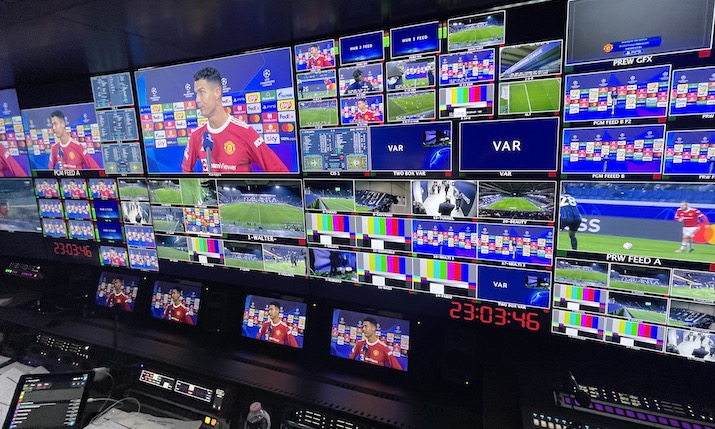When Atalanta met Manchester United at the Gewiss Stadium in Bergamo earlier this month, it marked the first time in Italy that a UEFA Champions League match was produced entirely in native 4K HDR-HLG. It was available to Sky Q subscribers in the country.
“Everything stems from the desire to always do something better and to go beyond the competition for quality and production workflow,” says Ivan Pintabona, CTO of production company NVP.
“We must not forget our great maturity in terms of production in the field. We started experimenting with native HDR in 2017 with the first 4K OB van in Spain for La Liga, then the complex production of this year’s Olympics.”
NVP created a production workflow for Sky Italia that was able to meet UEFA’s requirement to deliver in HDR but at the same time also in SDR.
In partnership
Pintabona explains: “We deployed 20 4K HDR cameras and a production stream designed to natively handle extended dynamic range.
“For the first time we were able to produce an international live broadcast entirely in 4K HDR HLG in Italy, guaranteeing an exceptional result, created by the Sky Sport production team with our full technical support.
“In general, HDR productions in Italy to date have been viewed with some caution, given that past experiences were not always entirely perfect. 4K HDR has been considered a bit risky as it was thought the quality was not fully perceived by the viewer. Extensive skills and knowledge are also required.”
Pintabona continues: “The delicate moment is in image management and compatibility between SDR and HDR, and the real risk is in the down mapping and up mapping between REC709 technologies and the REC2020 wide colour gamut.
“In other words, we are faced with a pure photographic question of colour spectrum, which in the change of format can generate visible differences in the rendering of colours, as unfortunately has already been seen at times on air.
“In practice, the whole workflow must be taken care of in a certain way without neglecting any part of the internal production chain, even the part that is not native HDR, for example the VAR or the GLT [Goal Line Technology] which are provided by UEFA in SDR.”
In this case, NVP created special conversion LUTs, studied and optimised for this type of event and that have produced faithful results.
Two feeds were guaranteed and were produced in optimal quality, starting from the master feed in HDR: a 4K HDR 2020 feed for Sky and a 4K SDR 709 feed distributed to 80 countries that have acquired the rights of the match. The same was done for HD.
Pintabona continues: “Given the very high penalties at stake and the related problems in case of approximate results, I can say that it was a great responsibility but at the same time also a great opportunity that we have carried out with great dedication and to the satisfaction of all.
“We are proud to be able to give this guarantee thanks to our great research and experience in the field.”
A truly enhanced workflow
In addition to the 20 cameras in the field, the production of the match was also enriched by the use of Vizrt’s Viz Arena augmented reality graphics solution, applied directly on the pitch, the adoption of FanCam with EVS XtraMotion to offer super-slow-motion replays with the aid of cloud-based artificial intelligence, and the panoramic images captured by a drone that flew over the stadium.

For the first time at such an event, a FanCam, a cinema camera capable of photographing images with a documentary look and feel, was used. It featured in the pre-match coverage but was also used on the field and the crowd by director Federico Fazzini, the production team, including Ferruccio Zanotti, Giorgio Antoniol and Tommaso Martini, and all the Sky staff.
Also new, the cloud-based EVS XtraMotion replay system is based on artificial intelligence which allows users to push some clips at 50 frames per second which are returned with interpolated replay at 150fps with very high impact images.
A state-of-the-art drone, meanwhile, was used to show the teams arriving and in pre- and post-match coverage.
Pintabona emphasises: “Sky has created a very open team on the pitch that has worked very well, and the director has enhanced our technical suggestions, approving our ideas and integrating them in the best possible way into the strict UEFA running order, demonstrating the will to make the most of the product and our skill.”
Field experience
Two OB vans were used in the production, OB7 for the host feeds and OB4 for the customisation for Sky, with integration always in 4K HDR WCG pre- and post-game.
All the cameras in the field were Grass Valley LDX 86N natively set in HLG in full range 2020 to make the most of their potential.
The Vans used the GV Kahuna Full Fusion 4 video mixer and GV Sirius 850 router also from Grass Valley.
The points of complexity were the conversion LUTs and the integration of the graphics provided by UEFA and produced by Deltatre, and that therefore were not directly controlled by NVP.
The mobile vehicles are equipped with XT-Via technology, the new LSM-Via panels and the XHub-Via network from EVS.
All operators could send clips to the cloud thanks to a 100MB bidirectional connection provided by Sky in the field, with a minimum delay of 10/15 seconds.
When it comes to audio, the match was broadcast in 5.1 surround, but enhancements are in the pipeline here too. Pintabona says: “For the audio, still under UEFA directives, we did not start with immersive audio, but it is promised for a date not too far in the future.
“Another point much appreciated by insiders in this adventure is that Sky worked in classic mode, that is, managing a product in HDR, which usually imposes all its typical problems of complexity, without any limits in operation.
“In fact, all the typical normal possibilities of Serie A or Champions League football productions have been exploited: this too is part of that already expressed concept of studying a workflow aimed at giving a new type of experience also at a production level.”
Pintabona concludes: “We have focused and invested a lot on these technologies and the market has found us ready.This event was the official launch and in the near future we will also implement some other innovative solutions in terms of augmented reality and for cameras.”
Source: svgeurope.org
Vai all’articolo originale

